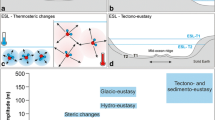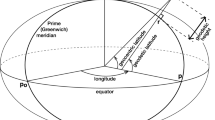Abstract
Stage A whitecaps (spilling wave crests) have a microwave emissivity of close to 1. Thus if even a small fraction of the sea surface is covered by these features there will be a detectable enhancement in the apparent microwave brightness temperature of that surface as determined by satellite-borne microwave radiometers. This increase in the apparent microwave brightness temperature can as a consequence be routinely used to estimate the fraction of the sea surface covered by stage A whitecaps. For all but the very lowest wind speeds it has been shown in a series of controlled experiments that the air-sea gas transfer coefficient for each of a wide range of gases, including carbon dioxide and oxygen, is directly proportional to the fraction of the sea surface covered by these stage A whitecaps.
Similar content being viewed by others
References
Andreas E L, Edson J B, Monahan E C, Rouault M P and Smith S D 1995 The spray contribution to net evaporation from the sea: A review of recent progress,Boundary-Layer Meteorology,72, pp. 3–52
Andreas E L and Monahan E C 2000 The role of whitecap bubbles in air-sea heat and moisture exchange;Journal of Physical Oceanography,30 pp. 433–442
Asher W E, Farley P J, Wanninkhof R, Monahan E C and Bates T S 1992 Laboratory and field experiments on the correlation of fractional whitecap coverage with air/sea gas transport;Precipitation Scavenging and Atmospheric Surface Exchange, Vol. 2, The Semonin Volume: Atmosphere-Surface Exchange Processes, (eds) S E Schwartz and W G N Slinn, (Washington, D.C.: Hemisphere Pubs.) pp. 815–827
Asher W E, Higgins B J, Karle L M, Farley P J, Sherwood C R, Gardiner W W, Wanninkhof R, Chen H, Landry T, Steckley M, Monahan E C, Wang Q and Smith P M 1995b. Measurement of gas transfer, whitecap coverage, and brightness temperature in a surf pool: An overview of WABEX-93;Air-Water Gas Transfer, (eds) B Jaehne and E C Monahan, AEON Verlag, Hanau, pp. 205–216
Asher W E, Karle I M, Higgins B J, Farley P J, Leifer I S and Monahan E C 1995a The effect of bubble plume size on the parameterization of air-seawater gas transfer velocities;Air-Water Gas Transfer, (eds) B Jaehne and E C Monahan, AEON Verlag, Hanau, pp. 227–238
Gloersen P and Barath F T 1977 A scanning multichannel microwave radiometer for Nimbus-G and SeaSat-A;IEEE Journal of Oceanic Engineering,2 pp. 172–178
Kerman B R 1984 A model of interfacial gas transfer for a well-roughened sea;Gas Transfer at Water Surfaces, (eds) W Brutsaert and G H Jirka, (Dordrecht: Reidel Pub.) pp. 311–320
Liss P S and Merlivat L 1986 Air-sea gas exchange rates: Introduction and Synthesis;The Role of Air-Sea Exchange in Geochemical Cycling, (ed) P Buat-Menard, (Dordrecht: Reidel Pub.) pp. 113–129
Monahan E C 1971 Oceanic Whitecaps;Journal of Physical Oceanography,1, pp. 139–144
Monahan E C 1989 From the laboratory tank to the global ocean,climate and Health Implications of Bubble-Mediated Sea-Air Exchange, (eds) E C Monahan and M A Van Patten, Connecticut Sea Grant College Program, Groton, pp. 43–63
Monahan E C 2002 The physical and practical implications of a CO2 gas transfer coefficient that varies as the cube of the wind speed;Gas Transfer at Water Surfaces (eds) M A Donelan, W M Drennan, E S Saltzman, and R Wanninkhof, (Washington, DC: American Geophysical Union Monograph),127 pp. 193–197
Monahan E C and Lu M 1990 Acoustically relevant bubble assemblages and their dependence on meteorological parameters;IEEE Journal of Oceanic Engineering,15, pp. 340–349
Monahan, E C and O’Muircheartaigh I G 1980 Optimal power law description of oceanic whitecap coverage dependence on wind speed;Journal of Physical Oceanography,10, pp. 2094–2099
Monahan E C and O’Muircheartaigh I G 1981 Improved statement of the relationship between surface wind speed and oceanic whitecap coverage as required in the interpretation of satellite data;Oceanography from Space, (ed) J F R Gower, (New York: Plenum Pub.) pp. 751–755
Monahan E C and O’Muircheartaigh I G 1986 Whitecaps and the passive remote sensing of the ocean surface;International Journal of Remote Sensing 7 pp. 627–642
Monahan E C and O’Muircheartaigh I G 1998 Inferring near-sea-surface wind speeds from oceanic whitecap coverage;Proceedings of PORSEC’98-Qingdao, Vol.1, (eds) M-X He and G Chen, PORSEC’98 Secretariat, Qingdao, pp. 622–626
Monahan E C, Spiel D E and Davidson K L 1986 A model of marine aerosol generation via whitecaps and wave disruption;Oceanic Whitecaps and their role in Air-Sea Exchange Processes, (eds) E C Monahan and G MacNiocaill, (Dordrecht: D. Reidel Pub.) pp. 167–174
Monahan E C and Spillane M C 1984 The role of oceanic whitecaps in air-sea gas exchange;Gas Transfer at Water Surfaces, (eds) W Brutsaert and G J Jirka, (Dordrecht: Reidel Pub.) pp. 495–503
Monahan E C and Torgersen T 1990 The enhancement of air-sea gas exchange by oceanic whitecapping;AirWater Mass Transfer, (eds) S C Wilhelms and J S Gulliver, (New York: American Society of Civil Engineers) pp. 608–617
Nordberg W, Conaway J, Ross D R and Wilheit T 1971 Measurements of microwave emission for a foam-covered, wind-driven sea;Journal of Atmospheric Sciences,28, pp. 429–435
O’Muircheartaigh I G and Monahan E C 1992 Modeling the dependence of whitecap on wind speed: hierarchical models, and shrunken parameter estimation;Preprints,Fifth International Meeting on Statistical Climatology, Toronto, pp. 553–556
Ross D B and Cardone V 1974 Observations of oceanic whitecaps and their relation to remote measurements of surface wind speed;Journal of Geophysical Research,79, pp. 444–452
Ross D B, Cardone V J and Conaway J W 1970 Laser and microwave observations of sea-surface condition for fetchlimited 17-to 25-m/s winds;IEEE Transactions on Geoscience and Electronics,8, pp. 326–336
Schluessel P and Luthardt H 1991 Surface wind speeds over the north sea from special sensor microwave/imager observations;Journal of Geophysical Research,96, pp. 4845–4853
Stogryn A 1972 The emissivity of sea foam at microwave frequencies;Journal of Geophysical Research,77, pp. 1658–1666
Wang Q, Monahan E C, Asher W E and Smith P M 1995 Correlations of whitecap coverage and gas transfer velocity with microwave brightness temperature for plunging and spilling breaking waves;Air-Water Gas Transfer, (eds) B Jaehne and E C Monahan, AEON Verlag, Hanau, pp. 217–225
Wanninkhof R and W R McGillis 1999 A cubic relationship between air-sea CO2 exchange and wind speed;Geophysical Research Letters,26, pp. 1889–1892
Webster W J, Wilheit T T, Ross D B and Gloersen P 1976 Spectral characteristics of the microwave emission from a wind-driven foam covered sea;Journal of Geophysical Research,81, pp. 3095–3099
Author information
Authors and Affiliations
Rights and permissions
About this article
Cite this article
Monahan, E.C. Oceanic whitecaps: Sea surface features detectable via satellite that are indicators of the magnitude of the air-sea gas transfer coefficient. J Earth Syst Sci 111, 315–319 (2002). https://doi.org/10.1007/BF02701977
Issue Date:
DOI: https://doi.org/10.1007/BF02701977




